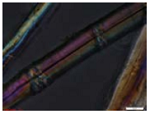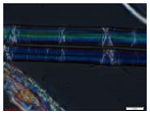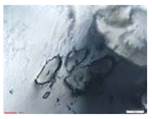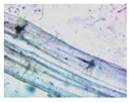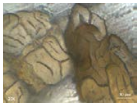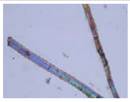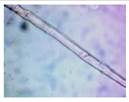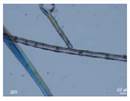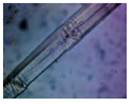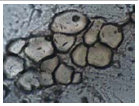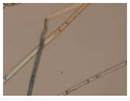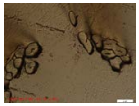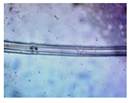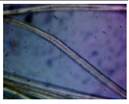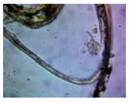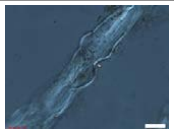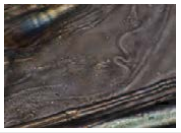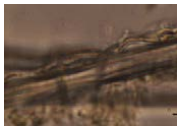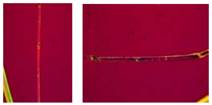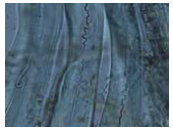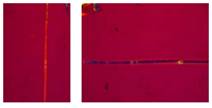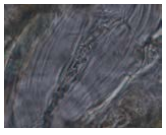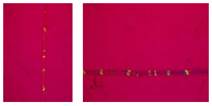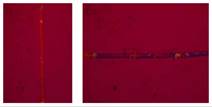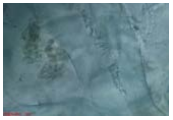Serviços Personalizados
Journal
Artigo
Indicadores
-
 Citado por SciELO
Citado por SciELO -
 Acessos
Acessos
Links relacionados
-
 Similares em
SciELO
Similares em
SciELO
Compartilhar
Intervención (México DF)
versão impressa ISSN 2007-249X
Intervención (Méx. DF) vol.13 no.26 México Jul./Dez. 2022 Epub 05-Dez-2023
https://doi.org/10.30763/intervencion.272.v2n26.51.2022
Research articles
Comprehensive Methodology for the Identification of Liberian Flax and Hemp Fibers in the Supports of New Spanish Paintings
* Escuela Nacional de Conservación, Restauración y Museografía (ENCRyM), Instituto Nacional de Antropología e Historia (INAH), México, analaura_avelar@inah.gob.mx
**Coordinación Nacional de Conservación del Patrimonio Cultural (CNCPC), Instituto Nacional de Antropología e Historia (INAH), México, victor_santos@inah.gob.mx
*** Instituto de Investigaciones Estéticas (IIE), Universidad Nacional Autónoma de México (UNAM), México, elsa_arroyo@comunidad.unam.mx
This research article presents the results from the application of a complementary analysis methodology for the accurate identification of Liberian fibers, specifically linen and hemp, used in the textile supports of easel paintings. The research focuses on six paintings attributed to various representative authors of New Spanish recognized plastic arts over a wide-ranging time frame spanning from the last third of the XVI century-until the end of the XVII century. During this paper we discuss the continuance detected in the process of intentional selection of canvases used for viceregal paintings in Colonial Mexico.
KEY WORDS: liberian fibers; flax; linen; hemp; New Spanish painting; optical microscopy; modified Herzog test; Schweitzer’s reagent
Este artículo de investigación presenta los resultados de la aplicación de una metodología de análisis complementaria para la correcta identificación de fibras liberianas, específicamente lino y cáñamo, usadas en los soportes textiles de las pinturas de caballete. La investigación se centra en seis cuadros firmados por autores representativos de la reconocida plástica novohispana en un rango temporal amplio: último tercio del siglo XVI-final del siglo XVII. Con esta revisión discutimos las continuidades detectadas en el proceso de selección intencional de las telas para la pintura virreinal de la Nueva España.
PALABRAS CLAVE: fibras liberianas; lino; cáñamo; pintura novohispana; microscopía óptica; prueba Herzog modificada; reactivo de Schweitzer
Presentation
In the vast array of aspects that make up the analysis of techniques and materials used in the creation of an easel painting, knowledge on the nature of its supports is fundamental. In this research article we present the results from the application of an integral and complementary methodology for the identification of the organic fibers that constitute the painting’s supports, in six paintings produced in workshops established in the capital of the viceroyalty of New Spain between 1610 and 1683 (Figure 1).
FIGURE 1 List of analyzed samples
| Code | Description | Name and author |
|---|---|---|
| NE235 M1 | Canvas | Baltasar de Echave Orio (attributed), El Pentecostés (The Pentecost), ca. 1610, oil on canvas attached to board, 259.5 x 174.5 cm; Gallery of the Temple of San Felipe Neri, La Profesa, Mexico City. |
| NE229C M5 | Canvas | Sebastián de Arteaga, Cristo en la Cruz (Christ on the Cross), ca. 1643, oil on canvas, 245 x 190 cm; collection: Museo Nacional de Arte, Mexico City. |
| NE229B M5 | Canvas | Sebastián de Arteaga, Los desposorios de la Virgen (The Betrothal of the Virgin), ca. 1645, oil on canvas, 223 x 171 cm; collection: Museo Nacional de Arte, Mexico City. |
| NE245C M6 | Canvas | Sebastián de Arteaga (attributed), El levantamiento de la cruz (The Raising of the Cross), n. d., oil on canvas, 270 x 202.5 cm; collection: Episcopal Gallery of the Catedral of Durango, Mexico. |
| NE233 M4 | Canvas | Baltasar de Echave Rioja, El lavatorio de pies (Foot Washing), 1681, oil on canvas, 195 x 245 cm; Temple of Santo Domingo de Guzmán, Izúcar de Matamoros, Puebla, Mexico. |
| NE232 M4 | Canvas | Cristóbal de Villalpando, El lavatorio de pies (Foot Washing), ca. 1683, oil on canvas, 196 x 252 cm; collection: Sacristy of the Temple of Nuestra Señora del Carmen, Puebla, Mexico. |
| NE245C M7 | Sewing | Sebastián de Arteaga (attributed), El levantamiento de la cruz (The Raising of the Cross), ca. 1640, oil on canvas, 270 x 202.5 cm; collection: Episcopal Gallery of the Catedral of Durango, Mexico. |
| NE233 M5 | Sewing | Baltasar de Echave Rioja, El lavatorio de pies, 1681, óleo sobre tela, 195 x 245 cm, Templo de Santo Domingo de Guzmán, Izúcar de Matamoros, Puebla, Mexico |
| NE232 M5 | Sewing | Cristóbal de Villalpando, El lavatorio de pies (Foot Washing), ca. 1683, oil on canvas, 196 x 252 cm; collection Sacristy of the Temple of Nuestra Señora del Carmen, Puebla, Mexico. |
Source: (Table: Ana Laura Avelar-Carmona, 2021).
We distinguish between the use of linen and hemp in canvases and stitching since these materials were the most commonly used in the manufacture of paintings on canvas in the viceregal period, and we emphasize the physical properties of these fibers to contribute new data enabling for a better understanding of the processes used by local artists when selecting raw materials, confronting the material identification of specific cases with the scarce documentary data recorded on the artistic technology used in Novo-Hispanic paintings.
Context: the use of liberian fibers in novo-hispanic painting
In the Mexican context, the use of fabrics for the manufacture of cultural artifacts dates to pre-Columbian cultures where early pieces were made from cotton fabrics usually boasting geometric designs that hint at a well-established textile culture from as least as early as 1200 BC. Although the country’s climatic conditions at the time had been unfavorable for the preservation of organic materials such as the Liberian fibers we reference here, we know from historical sources that there was a wide diversity of textiles present in the culture of Mesoamerican indigenous peoples (Ramírez, 2014, pp. 68-69).
After the Conquest, the range of textile fibers used for the production of decorative objects diversified due to transatlantic trade and the increasing demand for such goods from foreign populations. Archival sources reveal complete lists of the materials used on a daily basis in an art workshop. Such is the case of the payment account dated January 18th, 1585 by means of which Rodrigo Dávila, maestro mayor of the Old Cathedral of Mexico, gave the painter Andrés de Concha (active in New Spain between 1568 and 1611) 27 pesos and 6 tomines for the materials he used in the work for the main altarpiece: “ten rods of ruan [sic] to canvas [sic] many pieces and trimmings of the tabernacle”1 and “six rods of angeo [sic] for the finishes of the said altarpiece” (Archivo General de la Nación [AGN], Historia 112, in Zárate, 2020, p. 518). Both types of fabrics, despite slight differences in cost, were coarse weaves of simple bindings, made with linen or hemp threads; the name of the former derives from the production region in Europe (Bruquetas, 2002, p. 234).
Between 1979 and 2009, Rita Sumano’s research systematized and interpreted the information concerning the supports of the Novo-Hispanic paintings restored by the Escuela Nacional de Conservación, Retauración y Museografía (ENCRyM, National School of Conservation, Restoration and Exhibition Design), using statistical methods, which revealed that the fabrics used by the painters’ guild were, for the most part, low quality linen fabrics and, in many cases, were re-purposed (Sumano, 2010, pp. 4-5).
Examples, such as the fabric that reinforces the pine board in El Pentecostés (The Pentecost), attributed to Baltasar de Echave Orio (Guipúzcoa, 1558-New Spain, 1619), provide compelling evidence of the need to obtain the maximum benefit from every scrap of coarse fabric available to a workshop in New Spain during this period. Here, radiography allowed us to confirm the placement of strips of fabric of different thicknesses and textures, stretched horizontally on the planks that make up the panel. It seems that the use of textile scraps to reinforce the boards was a common practice in Echave Orio’s workshop, as we detected a similar reinforcement in the painting El martirio de san Ponciano (The martyrdom of Saint Pontian) from 1605 (Cuadriello et al., 2018, p. 196) (Figure 2).
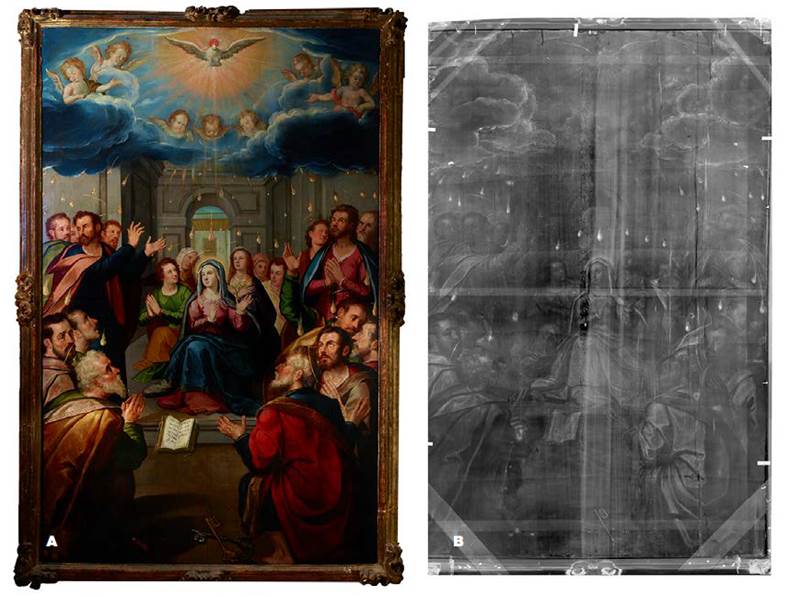
Source: (Photograph: Eumelia Hernández, 2018; X-ray: Oscar de Lucio; courtesy: A. Laboratorio de Diagnóstico de Obras de Arte [LDOA]-Instituto de Investigaciones Estéticas [IIE] and B. Instituto de Física [IF], both of Universidad Nacional Autónoma de México [UNAM]/D. R. Secretaría de Cultura and Instituto Nacional de Antropología e Historia [INAH]).
FIGURE 2 The Pentecost, 242 x 152 cm (ca. 1610), oil on panel by Baltasar de Echave Orio. A. Work seen with visible light and B., with X-rays. The work is in the collection of the Oratorio de San Felipe Neri, in the Casa Profesa in Mexico City.
Similarly, we have noticed the use of fabrics with irregularities in the monumental scene of Moisés y la serpiente de bronce; y la transfiguración de Jesús (Moises and the bronze serpent, and the transfiguration of Jesus), painted by Cristóbal de Villalpando (Mexico City, ca. 1649-1714) for the Cathedral of Puebla, where complete linen canvases from the same lot were used, sewn by the selvage “overcast stitch”, to form the central areas of the work, being complemented -at each end of the lunette- with defective fragments that have small holes distributed according to a quadrangular pattern (Arroyo, 2017, p. 7) (Figure 3).
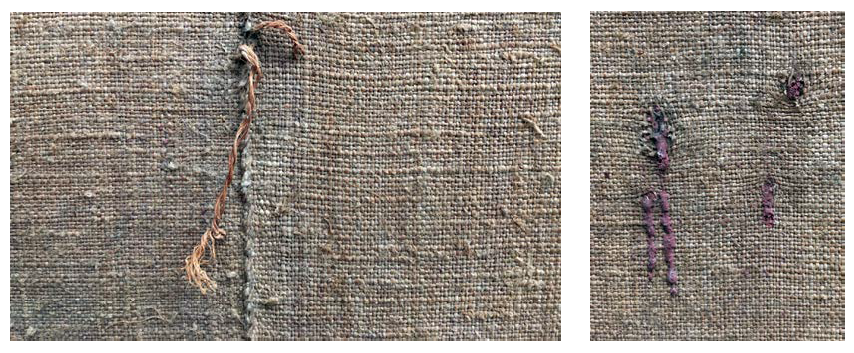
Source: (Photograph: Eumelia Hernández, 2017; courtesy: D. R. Secretaría de Cultura and INAH).
FIGURE 3 Canvas details of Cristóbal de Villalpando’s Moses and the bronze serpent, and the transfiguration of Jesus, 856 x 427 cm (1683), oil on canvas. Work located in the collection of the Cathedral of Puebla, Puebla
Although most of the canvases used in viceregal paintings have been identified as belonging to the linen genre, it is important to point out that hemp fiber was also used, as well as maguey fiber, which, in the case of the pictorial works, seems to have been used to make the threads for the seams. In his opuscule on the Virgin of Guadalupe, Miguel Cabrera observed that the painting conserved in the hill of Tepeyac was made on a canvas composed of two fragments of a “crude” fabric of a very open weft, whose color and texture “is similar to the rough canvas or Bramante of Europe, that here we call Cotenze”2 (Cabrera, 1756, p. 3). According to the Diccionario de autoridades (1726), the word bramante referred to a thick cloth made of hemp. It is not strange then that, as a result of his observations of the miraculous image, Miguel Cabrera decided to use cotenze in his two versions of the Virgin of Guadalupe painted in 1756, one for the Jesuit college in Tepotzotlán and the other for the chapel of the same denomination in the Cathedral of Puebla (Ángeles & Arroyo, 2021, p. 200).
Phloem or liberian fibers
Several types of fibers are extracted from plants, including soft fibers, Liberian fibers or, more precisely, phloematic fibers (known also as bast fibers). These are part of the phloem, a conductive tissue that forms the inner cortex of plants, and provides stems with their resistance to mechanical stress Azcárraga et al., 2010, p. 93). Linen fibres (Linum usitatissimum L.) and hemp fibers (Cannabis sativa L.) have similar characteristics, so there is a high risk of misidentification (Luniak, 1953, p. 129; Kvavadze et al., 2009, p. 1359), even more so if they come from textiles that have suffered a high degree of deterioration.
Taxonomic identification allows the recognition of features, traits or intrinsic properties that a specimen under study shares with one or another taxon (e.g., family, genus or species), and is regularly carried out by means of descriptions, identification keys, atlases or comparison specimens (Mishler & De Luna, 1997, p. 46; Iriondo, 2000, p. 2).
The taxonomic identification of fibers present in cultural objects has traditionally been carried out by means of qualitative techniques, read, the observation of their morphology in the optical microscope (Mirambell & Sánchez, 1986, p. 34) or combustion, staining or microchemical tests, where their behavior is observed before chemical reagents of various kinds. However, these procedures are not able to precisely differentiate between types of bast fibers (Suomela et al., 2017, p. 415).
Theoretical foundations of the analyses performed
Morphology
A plant fiber is an elongated, narrow cell, with sharp ends; it has a lumen or cavity and a wall constituted, in turn, by two walls, an external one, called primary wall, and an internal one, called secondary wall Azcárraga et al., 2010, p. 93); it can present cross-linking markings and dislocations or nodes. Such marks are striations transverse to the fiber’s surface-sometimes also presenting longitudinal striations-so much so that it is possible to observe their faint or strong markings (Catling & Grayson, 2004, p. 3; Suomela et al., 2017, p. 413). Dislocations are visible as ring-shaped marks, coarsening or knots that are generated by a change in fiber direction due to external or internal stresses (Catling & Grayson, 2004, p. 1; Suomela et al., 2017, p. 413) (Figure 4). It should be added that there is no consensus in literature on the origin and definition of these markings.
FIGURE 4 Photomicrographs of standard fibers: flax and hemp
| Pattern | Section type | Microchemical with Schweitzer’s reagent | Modified Herzog test | |
|---|---|---|---|---|
| Longitudinal | Cross | |||
| A | B | C | D | |
| Linen |
|
|
|
|
| Fibers with “X” X-shaped dislocations and crossover marks | Thick-walled, four-, five, and six-sided fibers with flat surfaces with reduced lumens | Spiral fiber contraction | Color change at 90° yellow and at 0° blue | |
| Hemp |
|
|
|
|
| Fibers with well-marked dislocations and some crossing marks | Thick-walled fibers and small lumens | Fiber shrinkage in folds | Color change at 90° yellow and at 0° blue | |
Source: (Optical microscopy and microchemistry: Victor Santos Vázquez, 2020; micrographs of modified Herzog’s test: Ana Laura Avelar-Carmona, 2020; courtesy: Laboratorio de Biología, Escuela Nacional de Conservación, Restauración y Museografía [ENCRyM] and Instituto Nacional de Antropología e Historia [INAH]).
Linen
Linen is a shrubby plant of Asian origin, specifically from southeastern Turkey (Fu, 2005, p. 1084), whose uses date back to ancient Egypt (Elsharnouby & Ahmed, 2015, p. 3). Its filaments may be grouped in bundles or bunches with 12 to 40 useful fibers (Hall & Davies, 1968, p. 23). The average length of flax fibers is between 1.6 mm and 24.0 mm, or even up to 30 cm, while the diameter ranges from 11.7 to 32 mµ, or even up to between 40 to 80 mµ (Campo et al., 2009, p. 18). It should be noted that these dimensions vary according to the consulted author and the processes of crimping, debarking and stranding of the yarns (Houck, 2009, pp. 3-14 and 247). The width is usually uniform along its entire length (Campo et al., 2009, p. 18; Florian et al., 1994, p. 49); its wall has cross-linking marks and X-shaped dislocations (Campo et al., 2009, p. 18; García, 2007, p. 137; Florian et al, 1994, p. 49; Hall & Davies, 1968, p. 23; Mattews, 1934, p. 750); they are generally located at a more or less fixed distances, a feature that, according to Hall & Davies (1968, p. 23), is particular to flax. Its lumen is observed as a thin, dark line (Florian et al., 1994, p. 49; Hall & Davies, 1968, p. 23; Mattews, 1934, p. 750) and discontinuous, as the cell walls thicken in sections, until the lumen closes completely, a peculiarity that, according to some authors (Campo et al., 2009, p. 19; García, 2007, p. 137), can separate flax from hemp. Transversely it shows triangular, pentagonal or hexagonal shapes, and the contours are slightly rounded, with oval lumens (Mattews, 1934, p. 750; Von Berger & Krauss, 1942, p. 27; García, 2009, p. 137) (Figure 4).
Hemp
Hemp is a type of shrub native to Central Asia (Hillig, 2005, p. 170). It can reach heights of up to 2 m (García, 2007, p. 133) and the morphological characteristics of its fibers, although similar to those of flax, are less transparent and more rigid (Campo et al., 2004, p. 19; Catling & Grayson, 2004, p. 22; García, 2007, p. 134). They are 5 to 55 mm long and 10 mµ wide (Florian et al., 1990, p. 49). The lumen, regular, wide and continuous, covers half or three quarters of the wall (Campo et al., 2004, p. 19; Catling & Grayson, 2004, p. 22; García, 2007, p. 134) and diminishes towards the ends of the filaments (Campo et al., 2004, p. 19); its width is irregular, as it varies along the fiber (Florian et al., 1990, p. 49). X-shaped dislocations are frequent, pronounced and irregularly arranged along the filaments; some specimens have lines, striations or folds parallel to the fiber axis (Campo et al., 2004, p. 19; Catling & Grayson, 2004, p. 22; García, 2007, p. 134). It should be noted that sometimes they are bifurcated at each end (Catling & Grayson, 2004, p. 22; García, 2007, p. 134.), although this feature can be observed in other types of fibers, including flax (Catling & Grayson, 2004, p. 22).
Differences between linen and hemp
Transversely, they are polygonal, with angular edges of four, five or even six sides; in other cases, they are oval or circular. Their lumen may be observed as broad, if the walls are thin, or as narrow, if they are wide (Catling & Grayson, 2004, p. 22) (Figure 4).
The presence of calcium oxalate crystals is also a feature that is useful to differentiate between linen fibers, which do not contain them, and hemp fibers that do, showing rhombohedral, prismatic or druse shapes (Catling & Grayson, 2004, p. 23). Since their presence is subject to various factors, e.g., the age of the plants and the environmental conditions in which they grow, and whether they have been bleached or boiled (Hall & Davies, 1968, p. 25; Florian et al. 1990, p. 49; Bergfjord & Holst, 2010, pp. 1192-1193), failure to detect them in microscopic analysis is not definitive in identifying them.
The shape of cross-sections, cross-linking marks and X-shaped dislocations have been used to identify Liberian fibers; how ever, previous studies have shown that they are not a feature that contributes to effective differentiation between them (Lukesova & Holst, 2020, p. 9).
Tests for the identification of liberian fibers
Modified Herzog test or delayed filter test (λ)
This analysis is based on the fact that plant fibers are composed of a lumen or cavity and a cell wall containing various chemical compounds, mainly cellulose, and, among others, lignin and hemicellulose: for example, flax contains 71% cellulose and 2% lignin, and hemp, 75% and 4% respectively (Avérous & Le Digabel, 2006). The cell wall, in turn, is made up of a primary and a secondary wall (three different layers make up the latter), both of which are formed by microfibrils, and these in turn by more microfibrils-cellulose chains with birefringent3 properties; those of the thickest layer of the secondary wall have a helical arrangement and can rotate either to the right (forming S helices) or to the left (forming Z helices), determining the microfibrillar orientation according to the letters S or Z, which is the path taken by the microfibrils with respect to the observer (Strasburger et al., 2004, p. 95). Flax has a characteristic S twist, while hemp has a Z twist (Strasburger et al., 2004, p. 95; Haugan & Holst, 2013, p. 160; Suomela et al., 2017, p. 414), varying the birefringent properties of each.
This property allows the Herzog test to be applied using a microscope with a polarizer. If the type of fiber present has a Z-twist, as in the case of hemp, when parallel to the polarizer (vertical) it will turn blue, when parallel to the analyzer (horizontal), yellow, and then the opposite will be true: yellow vertically and blue horizontally, when the fiber has an S-twist, as is characteristic of flax (Figure 4. Flax D and Hemp D) (Haugan & Holst, 2013, pp. 166-167). For the accurate execution of this test, it is necessary to first set the microscope parameters using reference fibers (Suomela et al., 2018, p. 418) (Figure 4).
Microchemical analysis: Schweitzer’s reagent test
This analysis technique is specific for vegetable fibers and has a destructive effect, so it is only recommended to be used as an alternative to optical microscopy, if a sufficient amount of the sample is available. It is useful to differentiate between linen and hemp fibers, mainly when the state of deterioration of the specimens prevents observing the morphological features of the fibers by means of optical microscopy.
In this test the fiber is put into contact with an ammoniacal solution of cupric hydroxide capable of dissolving the cellulose, after which a cellulose-copper complex is formed. Once the cell wall is dissolved, the resulting filament acquires feature shapes depending on the cellulose distribution. When a flax fiber is subjected to this test, the lumen contracts forming a spiral, whereas, in hemp, the internal cavity forms transverse folds (Campo et al., 2009, p. 25) (Figure 4. Flax C and Hemp A). Here we follow the methodology of T. A. Geissman (1974) applied effectively on heritage objects (Juanes et al., 2008, p. 75). Figure 4 shows the microphotographs of two standard samples analyzed by the three methods described.
APPLIED METHODOLOGY
The application of the three methods of identification of Liberian fibers was performed on bundles or individual fibers (Figure 5).
FIGURE 5 Sampling and sample preparation method in the laboratory
| Method of sampling and preparation of samples in the laboratory |
| Sampling was carried out in accordance with the techniques for global analysis of works of art, as well as with prior careful observation of the case study, in order to remove only the material necessary to answer the research question (Gómez, 2000, p. 183). A sample was extracted from each work under study (a thread less than 5 mm in length was sufficient) trying to damage the artistic object as little as possible, these were taken from the edges of each painting, near the area of union between fragments or around of tears. The samples were placed inside vials and in hermetically sealed plastic capsules to guarantee their safety during transport to the laboratory. Each one was labeled with a number that begins with the identity of the analyzed painting (inventory of works analyzed in the Laboratorio de Diagnóstico de Obras de Arte, del Instituto de Investigaciones Estéticas (LDOA-IIE-UNAM)). |
| Shredding and mounting of samples |
|
Preliminary registration. The loose fibers were observed under the Carl Zeiss XZ10 stereoscopic microscope with tungsten light, in the LDOA-IIE-UNAM. Its physical properties were described: color, texture, firmness and conservation status. A photographic record was made with the Carl Zeiss Axiocam camera in both directions of the fibers: transverse and longitudinal. |
| Longitudinal view |
| • Preliminary registration. Defibration and selection of fibers for assembly. This process was carried out dry with the help of a scalpel, dissection needle and under the light of the stereoscopic microscope. Depending on the state of conservation of the selected fiber, they were subjected to an aqueous cleaning process by immersion in hot water for 5 min (without agitation). |
| • Permanent mounting in longitudinal section. A bundle of fibers was placed on a transparent glass slide and a second stripping was carried out under a stereoscopic microscope in order to obtain isolated filaments. Afterwards, McCrone® Cargille Meltmount mounting medium was added, a polymer that melts at 25ºC and whose refractive index is 1.662. |
| Cross view |
| • A bundle of fibers was adhered to the lateral face of a resin polyhedron that is embedded in a silicone mold filled with Struers’ Clarocit® acrylic medium, thus ensuring the total impregnation of the specimen. Once solidified, the surface of the sample was polished with 200 mm diameter, 5 micron diamond film sandpaper, of various grits (800, 1000, 1200) to mirror point. |
Source: (Table: Victor Santos Vázquez, 2020).
A. Optical microscopy (OM) with polarized light (PLM) and transmitted light (TL).
Morphological analysis of the fibers (length, walls, dislocations, cross-linking marks, lumen and general shape) was performed with an Olympus BX51 optical microscope equipped with an Olympus DP72 high-resolution camera. The images were processed using Olympus Cell-Sens Dimension software®. The aforementioned equipment is located in the facilities of the Chemistry-Biology Laboratory of the National Coordination for the Conservation of Cultural Heritage (CNCPC) of the National Institute of Anthropology and History (INAH).
B. Modified Herzog test
This analysis was performed based on the Herzog test, modified by Haugan and Holst (2013, p. 166), for which an Olympus BX43 petrographic microscope with an Olympus EG20 integrated camera was used. The images were processed using AxioVision software.
To conduct this test it is necessary, to first perform a search using the 10X lens the fiber on which the analysis will be carried out. Once located, it must be positioned, with the help of the rotating plate, at an angle α = 0°. Subsequently, the objective is changed to 40X: the fiber is then observed with crossed polars/nicols and the analyzer is set until the fiber is brought to the extinction angle, which is achieved when it, or a fragment of it, is extinguished, i.e., it “disappears” or darkens.
Then, the compensator or λ-foil is inserted, at which time the background should appear magenta or pink, then focusing our attention on a small segment of the fiber. Next, we rotate the stage at an angle of α = 90° and note the color change of the same section observed before α = 0°.
C. Preparation of Schweitzer’s reagent
The reagent for identification is prepared by dissolving copper sulfate in hot water. Then a 28% ammonia solution is added drop by drop, until the pale blue color of the copper sulfate is diminished, and the solution becomes transparent. This solution is then rinsed with water, filtered, and from the precipitate two or three drops of ammonium hydroxide are added, which gives an intense dark blue color. It is important to mention that this reagent is functional when freshly prepared before crystallization; after that occurs, it loses its effectiveness. Once the drop of the reagent is applied to the fiber, the shrinkage of the material is observed under optical microscopy (OM) and using polarized light (PLM), the images are captured.
Discussion of results
Figure 6 summarizes the results of the three complementary techniques used in this research for the precise identification of Liberian fibers. The yellow color highlights the properties assigned to flax according to the literature consulted, and in green, those related to hemp. The above shows that most of the analyzed fibers observed characteristics -especially- morphological characteristics of both flax and hemp, so that the correct interpretation of the constituent material of the analyzed paints was conducted by comparing the results obtained from both the modified Herzog test and with the chemical reaction of Schweitzer.
FIGURE 6 Results of the three techniques used and their identification
| Sample | Morphology | Schweitzer’s | Herzog’s | Identification | ||
|---|---|---|---|---|---|---|
| Shape and borders | Dislocations | Lumen | ||||
| NE235 M1 | Pentagonal Hexagonal Straight |
No defined pattern | Discontinuous | Fold | 90° blue 0° yellow |
Hemp• |
| NE229C M5 | Pentagonal Hexagonal Straight and rounded |
No defined pattern | Continuous and reduced | Spiral | 90° yellow 0° blue |
Linen• |
| NE229B M5 | Pentagonal Straight and rounded |
Regular distances | Discontinuous | Inconclusive | 90° yellow 0° blue |
Linen• |
| NE245C M6 | Pentagonal Straight and rounded |
Regular distances | Discontinuous, reduced and wide | Spiral | 90° yellow 0° blue |
Linen• |
| NE233 M4 | Pentagonal Straight |
Regular distances | Discontinuous | Spiral | 90° yellow 0° blue |
Linen• |
| NE232 M4 | Square, Pentagonal Straight and rounded |
Regular distances | Discontinuous | Spiral | 90° yellow 0° blue |
Linen• |
| NE245C M7 | Pentagonal Hexagonal Straight and rounded edges |
Regular distances | Continuous and wide | Inconclusive | 90° yellow 0° blue |
Linen* |
| NE233 M5 | Squares Pentagonal Hexagonal Straight and rounded |
Regular distances | Discontinuous | Fold | 90° blue 0° yellow |
Hemp* |
| NE232 M5 | Squares Triangular Pentagonal Straight and rounded |
No defined pattern | Discontinuous | Fold | 90° blue 0° yellow |
Hemp* |
| Properties related to flax. | • Canvas | |||||
| Hemp related properties. | * Sewing | |||||
Source: (Table: Ana Laura Avelar-Carmona, 2021).
Figures 7 and 8 show the evidence of the results obtained in each of the tests performed on the samples of the fibers of the support of the New Spanish paintings.
FIGURE 7 Morphology
| Painting | Longitudinal section | Cross section | |
|---|---|---|---|
| A | B | C | |
| NE235 M1 |
|
|
|
| NE229C M5 |
|
|
|
| NE229B M5 |
|
|
|
| NE245C M6 |
|
|
|
| NE233 M4 |
|
|
|
| NE232 M4 |
|
|
|
| NE245CM7 |
|
|
|
| NE233 M5 |
|
|
|
| NE232 M5 |
|
|
|
Source: (Micrographs: Victor Santos Vázquez, 2020; courtesy: Laboratorio de Química, Research area of the CNCPC-INAH).
FIGURE 8 Results of microchemical tests and the Herzog test
| Sample | Microchemistry Schweitzer’s reagent | Herzog test |
|---|---|---|
| A | B | |
| NE235M1 |
|
|
| NE229C M5 |
|
|
| NE229B M5 |
|
|
| NE245C M6 |
|
|
| NE233 M4 |
|
|
| NE232 M4 |
|
|
| NE245C M7 |
|
|
| NE233 M5 |
Pliegue |
|
| NE232 M5 |
|
|
Source: (Optical microscopy and microchemistry: Victor Santos Vázquez, 2020; micrographs of modified Herzog’s test: Ana Laura Avelar-Carmona, 2020; courtesy: Laboratorio de Biología, Escuela Nacional de Conservación, Restauración y Museografía [ENCRyM], Instituto Nacional de Antropología e Historia [INAH]).
All the samples of Liberian fibers analyzed presented dislocations or X-shaped nodes; therefore, this morphological feature does not allow a precise identification of the material used as support in the paintings (Figure 7. A and B).
Of the nine samples studied, only three: NE229BM5, NE232M4 and NE233M4, presented in their entirety morphological characteristics reported in the known properties of flax, that is, equidistantly distributed dislocations and reduced and discontinuous lumen that closes in sections (Campo et al., 2009: 18; García, 2007, p. 137; Florian et al., 1994, p. 49; Hall & Davies, 1968, p. 23; Mattews, 1934, p. 750). Additionally, they came up positive for flax in the modified Herzog and microchemical tests.
Samples NE235M1 and NE232M5 presented dislocations without any specific distribution, which is indicative of hemp fibers (Campo et al., 2004, p. 19; Catling & Grayson, 2004, p. 22; García, 2007, p. 134); however, their lumen went from continuous to discontinuous and reduced, as it is supposed to occur with flax fibers. Finally, these samples tested positive for hemp with Schweitzer’s reagent and the modified Herzog’s test, highlighting the importance of using a combined methodology for their correct identification.
In fact, samples NE229CM5, NE233M5, NE235M1, NE232M5, NE245CM6 and NE245CM7, i.e., more than half of the fibers under study, were representative examples of the problems faced by a researcher during the process of analyzing heritage materials. Under the optical microscope they presented morphological elements corresponding to flax, hemp or even both fibers. Only by applying the complementary tests of Herzog and microchemistry with Schweitzer’s reagent were results obtained that helped to make a correct identification. For example, sample NE245CM7 presented X-shaped dislocations at regular distances, as would flax, and its lumen was wide and continuous, a characteristic associated with hemp. The microchemical test was inconclusive, as the fiber contracted in an unidentified form, and only the Herzog test was positive for flax.
The shape of the fibers in cross section did not present an important value for their identification, since both hemp and flax fibers observed triangular, square, pentagonal, hexagonal, straight and rounded edges (Figure 7. C), which corresponds with Lukesova & Holst (2020, p. 9), who also found no significant differences between the cross-sections of the two organic materials.
By carrying out a complementary analysis methodology with microchemistry and the Herzog test, it was possible to establish a different identification of the resulting morphology. Only the combination of analyses can guarantee reliable results, especially considering that in ancient paintings both the state of conservation of the material and even the process of plant growth, extraction and the complete processing of textile production modify the physical characteristics of a fiber.
In the identification methodology we used, we considered it a necessary criterion that at least two analyses should match, and to validate the results further it was necessary to apply the tests to more than one fiber. Regarding the test performed with Schweitzer’s reagent, it rarely matched with the other analyses, due to the amount of fiber used, the speed of the reaction and the degree of subjectivity involved in the interpretation of the resulting contractions. In all the cases analyzed, the Herzog test also linked with the other techniques used and was considered decisive in achieving the identifications. Therefore, its effectiveness in differentiating between flax and hemp was confirmed, even considering the thickness and deformations that the fibers may undergo, either by deterioration, by the growth of the fibers themselves or due to the textile manufacturing process.
CONCLUSIONS
This research has shown that, in order to carry out the taxonomic identification of Liberian hemp and flax fibers, it is necessary, as already suggested by other authors, to apply a complementary analysis methodology, especially if morphological analysis is included, since both fibers present similar characteristics, even the X-shaped dislocations (Hall & Davies, 1968, p. 23), and their distribution along the filaments and the shape of the lumen (Florian et al., 1994, p. 49; Hall & Davies, 1968, p. 23; Mattews, 1931, p. 750; García, 2009, p. 137; Campo et al., 2009, p. 19). This work demonstrates that based on morphology alone there is a high possibility of misidentification.
From the analysis of six New Spanish paintings, whose period of manufacture extends from the end of the 16th to the 17th century, we conclude that linen was the material most used in the supports. Its presence is associated with both the fabrics and the stitching (Figure 9). On the other hand, in the example of paintings on panel selected in the set, hemp is present in the reinforcements of the panels (Figure 2).
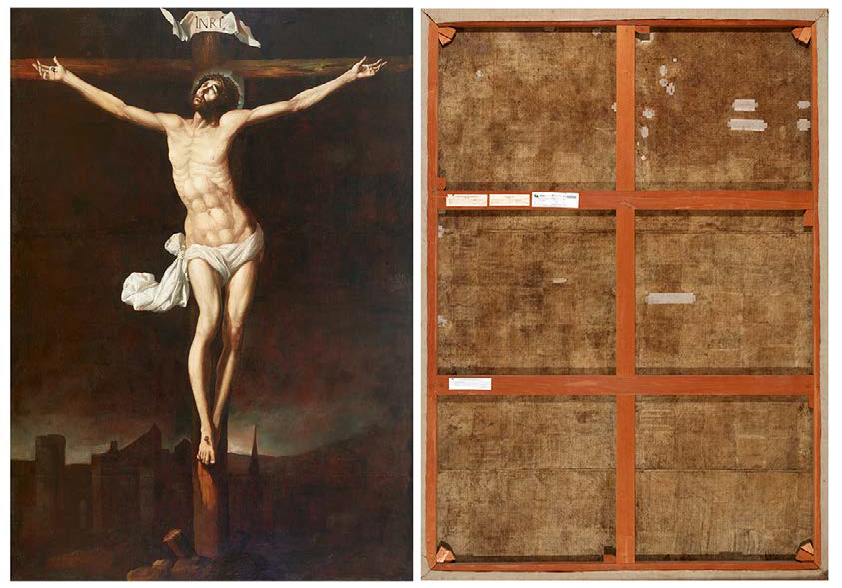
Source: (Photographs: Eumelia Hernández, 2019; courtesy: D. R. Secretaría de Cultura and Instituto Nacional de Bellas Artes y Literatura [INBAL]).
FIGURE 9 Sebastián de Arteaga, Christ on the Cross, 245 x 190 cm (ca. 1645), oil on canvas. Museo Nacional de Arte. D. R. Secretaría de Cultura. INBAL, Mexico
The preference to use linen as a support for the New Spanish viceregal paintings may be explained by its chemical composition, since, compared to hemp, linen has more cellulose. This confers to the vegetal cells their traction force-be it Liberian or Xilema fibers-that is to say, it makes them resistant when they are submitted to two forces that act in opposite ways. Linen fiber stands are more tolerant to fluctuations in environmental conditions.
According to García (2007, p. 137), the strength properties of flax depend on the dislocations in its fibers, since when under tension, the knots disappear, and when the fiber relaxes, they reappear. And although other bast fibers, such as hemp, also exhibit dislocations, the lignin content of each fiber type also directly influences its strength. For example, the percentage elongation at break, i.e., the increase in length of a fiber before it breaks, is higher in flax (2.7-3.2) than in hemp (1.6), which is due to the fact that the lignin content in hemp makes it a stiffer and less flexible fiber. In sum, the physicochemical properties of the fibers could explain the preference of flax as a constituent material of the supports and linings of the New Spanish paintings.
ACKNOWLEDGMENTS
This research was carried out thanks to the UNAM-PAPIIT IA401019 Program “Sebastián López de Arteaga and the construction of a pictorial language in context”. We are grateful to Eumelia Hernández both for the imaging studies of the viceregal painting-carried out at the Laboratorio de Diagnóstico de Obras de Arteaga (LDOA) of the Instituto de Investigaciones Estéticas (IIE) of the Universidad Nacional Autónoma de México (UNAM)-and for editing the tables and photographs. Oscar de Lucio, from UNAM’S Institute of Physics, carried out the radiographic analysis of Baltasar de Echave Orio’s El Pentecostés. We would like to thank research professor and geological engineer Jaime Torres Trejo (†) for allowing us to carry out the Herzog tests in his laboratory with the Olympus BX43 microscope.
REFERENCES
Aldaba, M., Antó, J., Cayuela D. y Morales C. (2006). Teoría de la birrefringencia en fibras textiles. Boletín intexter del Instituto de Investigación Textil y de Cooperación Industrial (Universidad Politécnica de Catalunya), 130, 57-62. https://upcommons.upc.edu/bitstream/handle/2099/5671/7Birefringencia.pdf?sequence=1&isAllowed=y [ Links ]
Ángeles, P. y Arroyo, E. (2021). El pintor sabio y la maravilla americana. En Pintores y pintura de la maravilla americana (pp. 185-216). Fomento Cultural Citibanamex. [ Links ]
Arroyo, E. (2017). Transparencias y fantasmagorías: la técnica de Cristóbal de Villalpando. En La Transfiguración. Cristóbal de Villalpando, pintor mexicano del Barroco (pp. 1-14). Fomento Cultural Banamex. [ Links ]
Avérous, L. y Le Digabel, F. (2006). Properties of biocomposites based on lignocellulosic fillers. Carbohydr Polym 66(4), 480-493. doi: doi.org/10.1016/j.carbpol.2006.04.004 [ Links ]
Azcárraga, R. M., Jacques-Ríos, M.A., Bonfil-Campos, A. y Sandoval-Zapotitla, E. (2010). Atlas de anatomía vegetal. Universidad Nacional Autónoma de México. [ Links ]
Bergfjord, C. y Holst, B. (2010). A procedure for identifying textile bast fibers using microscopy: Flax, nettle/ramie, hemp and jute. Ultramicroscopy 110(9), 1192-1197. doi: https://doi.org/10.1016/j.ultramic.2010.04.014 [ Links ]
Bruquetas, R. (2002). Técnicas y materiales de la pintura española en los Siglos de Oro. Fundación para la Historia del Arte Hispánico. [ Links ]
Cabrera, M. (1756). Maravilla americana y conjunto de raras maravillas, observadas Con la dirección de las Reglas del Arte de la Pintura en la prodigiosa imagen de Nuestra Sra. de Guadalupe de México por don Miguel Cabrera, pintor del Illmo. Sr. D. D. Manuel Joseph Rubio, y Salinas. Dignissimo Arzobispo de Mexico, y de el Consejo de Su Magestad, &c. A quien se la consagra. México, en la Imprenta del Real y más antiguo Colegio de San Ildefonso [reproducción electrónica]. Universidad Nacional Autónoma de México, Dirección General de Bibliotecas, 2010. http://132.248.9.195:8080/fondoantiguo1/1205490-652110/JPEG/Index.html [ Links ]
Campo, G., Bagan, R. y Oriols, N. (2009). Identificació de fibres. Suports tèxtils de pintures. Catalunya: Centre de Restauració de Béns Mobles de la Generalitat de Catalunya. [ Links ]
Catling, D. y Grayson, J. (2004). Identification of Vegetable Fibres. Archetype Books. [ Links ]
Cuadriello, J., Arroyo, E., Zetina, S. y Hernández, E. (2018). Ojos, alas y patas de la mosca. Visualidad, tecnología y materialidad de El martirio de san Ponciano de Baltasar de Echave Orio. Instituto de Investigaciones Estéticas-Universidad Nacional Autónoma de México. [ Links ]
Elsharnouby, R. y Ahmed, M. (2015). Linen in Ancient Egypt. Journal of the General Union of Arab Archeologists, 15, 1-22. https://jguaa.journals.ekb.eg/article_3087_b97ae56f7bc490c84879a457e8a9ba0a.pdf [ Links ]
Florian, M. L. E., Kronkright, D. P. y Norton, R. E. (1990). The Conservation of Artifacts Made from Plant Materials. The Getty Conservation Institute. https://www.getty.edu/conservation/publications_resources/pdf_publications/pdf/cons_artifacts.pdf [ Links ]
Fu, Y.-B. (2005). Geographic Patterns of RAPD Variation in Cultivated Flax. Crop Science, 45(3), 1084-1091. doi: https://doi.org/10.2135/cropsci2004.0345 [ Links ]
García, J. A. (2007). Fibras papeleras. Universidad Politécnica de Catalunya/Ediciones UPC. [ Links ]
Geissman, T. A. (1974). Principios de Química Orgánica (2ª ed.). Editorial Reverté. [ Links ]
Gómez González, M. L. (2000). Examen científico aplicado a la conservación de obras de arte. Madrid: Cátedra. [ Links ]
Hall, C. E. M. y Davis, M. S. T. (1968). Identificación de fibras textiles. Blume. [ Links ]
Haugan, E. y Holst, B. (2013). Determining the fibrillar orientation of bast fibers with polarized light microscopy: The modified Herzog test (red plate test) explained. Journal of Microscopy, 252(2), 159-168. doi: https://doi.org/10.1111/jmi.12079 [ Links ]
Hillig, K. W. (2005). Genetic evidence for speciation in Cannabis (Cannabaceae). Genetic Resoures Crop Evolution, 52(2), 161-180. doi: https://doi.org/10.1007/s10722-003-4452-y [ Links ]
Houck, M. (2009). Identification of Textile Fibers. Woodhead Publishing. [ Links ]
Iriondo, J. M. (2000). Taxonomía y conservación: dos aproximaciones a un mismo dilema. Portugaliae Acta Biológica, 19(1-4), 1-7. https://dialnet.unirioja.es/servlet/articulo?codigo=2374362# [ Links ]
Juanes, B. D., Marín, C. y Gómez, A. (2008). Aplicaciones de la microscopía óptica y electrónica de barrido. En La ciencia y el arte. Ciencias experimentales y conservación del Patrimonio Histórico Español (pp. 68-80). Instituto del Patrimonio Histórico Español-Ministerio de Cultura. [ Links ]
Kvavadze, E., Bar-Yosef, O., Belfer-Cohen, A., Boaretto, E., Jakeli, N., Matskevich, Z. y Meshveliani, T. (2009). 30,000-Year-Old Wild Flax Fibers. Science, 325(5946), 1359-1359. doi: https://www.science.org/doi/10.1126/science.1175404 [ Links ]
Lukesova, H. y Holst, B. (2020). Is Cross-Section Shape a Distinct Feature in Plant Fibre Identification? Archaeometry, 63(1), 216-226. doi: 10.1111/arcm.12604 [ Links ]
Luniak, B. (1953). The Identification of Textile Fibres. Qualitative and Quantitative Analysis of Fibre Blends. Pitman & Sons. [ Links ]
Mattews, J. M. (1931). The Textile Fibers: Their Physical, Microscopical and Chemical Properties. John Wiley and Sons. [ Links ]
Mirambell, L. y Sánchez, F. (1986). Material arqueológico de origen orgánico: textiles. Instituto Nacional de Antropología e Historia. [ Links ]
Mishler, B. D. y Luna, E. de (1997). Sistemática filogenética y el concepto de especie. Boletín de la Sociedad Botánica, (60), 45-57. doi: https://doi.org/10.17129/botsci.1518 [ Links ]
Ramírez, R. (2014). El hilado y el tejido en la época prehispánica. Arqueología Mexicana, (E55), 68-69. [ Links ]
Strasburger, E., Noll, F., Shenck, H. y Schimper, A. F. W. (2004). Tratado de botánica (35° Ed. actualizada por Peter Sitte, Elmar W. Weiler, Joachim W. Kadereit, Andreas Bresinsky y Christian Körner). Ediciones Omega. [ Links ]
Sumano, R. (2010). Estudio de la técnica de manufactura de los soportes textiles de la pintura de caballete en México, siglos XVII al XIX (Tesis de licenciatura en Restauración de Bienes Muebles). Escuela Nacional de Conservación, Restauración y Museografía-Instituto Nacional de Antropología e Historia. [ Links ]
Suomela, J. A., Vajanto, K. y Räisänen, R. (2017). Seeking Nettle Textiles-Utilizing a Combination of Microscopic Methods for Fibre Identification. Studies in Conservation, 63(7), 412-422. doi: https://doi.org/10.1080/00393630.2017.1410956 [ Links ]
Von Bergen, W. y Krauss, W. (1942). Textile Fiber Atlas: A Collection of Photomicrographs of Common Textile Fibers. American Wool Handbook Company. [ Links ]
Zárate, E. (2020). Apéndice documental. Historias de pincel. Pintura y retablos del siglo XVI en la Nueva España (pp. 503-529). Instituto de Investigaciones Estéticas-Universidad Nacional Autónoma de México. [ Links ]
1Editorial translation. This quote and all quotes and description of terms where the original text is in Spanish are also editorial translations.
3Birefringence: different absorption of light, diachronism, depending on whether the light vibrates along the axis of the fiber or perpendicular to it. The greatest difference between the ordinary and extraordinary refractive indices in the same material is called birefringence, which translates into a difference in speed of light beams when traveling through the interior of these materials.
Received: December 08, 2021; Accepted: January 18, 2023; Published: September 18, 2023











 texto em
texto em 


